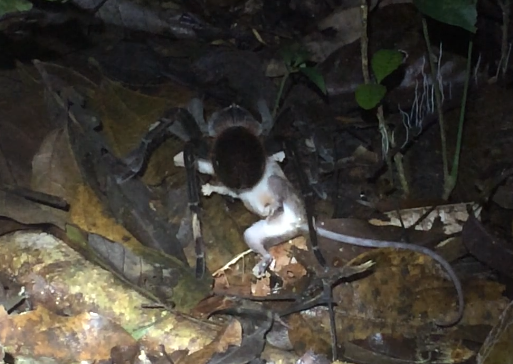
A tarantula (genus Pamphobeteus) preying on a mouse opossum (genus Marmosops): Maggie Grundler, Amphibian & Reptile Conservation
If you suffer from the phobia of arachnophobia, the a fear of spiders, you might not want to see this.
In a shocking bit of science that appears to be right out of a futuristic science fiction horror movie, Michigan researchers studying in the Amazon rainforest came across a large tarantula making a meal out of a small mouse opossum and stopped to make a video, which they posted on YouTube.
Ph.D. candidate Mike Grundler, who is studying ecology and evolutionary biology at the University of Michigan, made the discovery while hiking in the rainforest at night.
“We were just walking the trails, walking along slowly, and we heard a scrabbling in the leaf litter,” he says in the video. “And we looked over and we saw the tarantula on top of the possum. Finding a spider eating another mammal was very unexpected.”
He said the tarantula was roughly the size of a dinner plate.
An opossum expert at the American Museum of Natural History confirmed that the researchers had “captured the first documentation of a large mygalomorph spider preying on an opossum.”
“We were pretty ecstatic and shocked, and we couldn’t really believe what we were seeing, we knew we were witnessing something pretty special, but we weren’t aware that it was the first observation until after the fact,” Grundler said in a press release announcing the publication of a research paper in Amphibian & Reptile Conservation.
In other discoveries, the scientists documented Amazonian arthropod predators preying on frogs, lizards and snakes. They also witnessed a large centipede eating a coral snake.
“Coral snakes are very dangerous and can kill humans,” study co-author Joanna Larson said. “To see one taken down by an arthropod was very surprising. Those centipedes are terrifying animals.”













